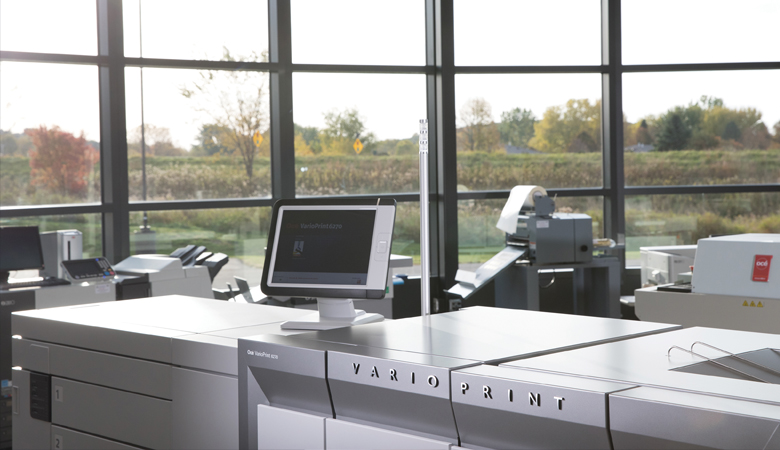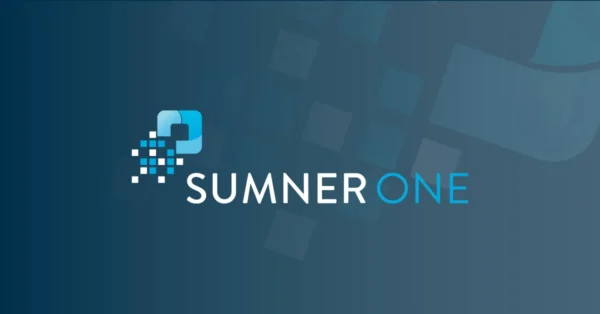EO Johnson, Virginia Business Systems, and Visual Edge IT discuss the challenges and triumphs of this high-end segment.
Editor’s note: Since last June, Frank has been interviewing dealers about their production print initiatives, focusing on how they got started, their production print partners, and how they’ve become successful in this segment. Above: A Canon varioPRINT is one of the many production printers on display at EO Johnson.
EO Johnson, Wausau, Wisconsin
Production Print Hardware OEMs: Canon, Ricoh, RISO, Horizon finishing equipment
EO Johnson is a dealership with a long and successful history in production print. We had the distinct pleasure of interviewing Dave Greene, president, and Jeff Reuter, director of production print.

Dave Greene
We started off by talking about the manufacturers they represent in Wisconsin and Minnesota. Headquartered in Wausau, Wisconsin, EO Johnson is a leading seller of Canon, Ricoh, and RISO hardware. The capabilities of the products dictate which device is sold to fit each unique customer’s needs. Canon is EO Johnson’s top revenue generator in production print, followed by Ricoh. The dealership also sells the Horizon finishing line, which drove $3 million in revenue last year.
The Pandemic’s Impact on EO Johnson’s Production Print Business
Asked how the pandemic affected the dealership’s production business, Greene and Reuter reported that this segment of the business experienced double-digit growth propelled by the sale of flatbed devices and digital presses in secondary markets. They further explained that their success was the geography the company serves, which comprises one of the top five print markets in the U.S. They also credited the growth of inkjet wide and large format printers.
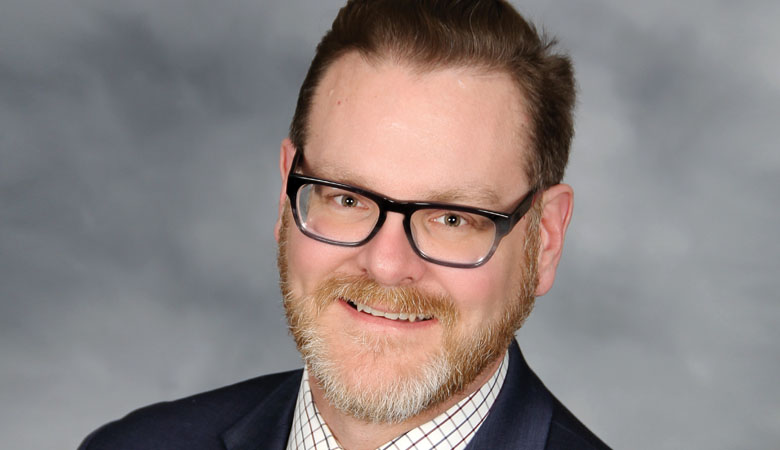
Jeff Reuter
Earlier this year at a dealer meeting in Philadelphia, Ricoh’s Brian Balow, vice president of production print, stated that Ricoh increased the total revenue of its production print business during the pandemic. EO Johnson grew its production print business in line with its OEM.
Building a Successful Production Print Organization
Being situated in a good market ripe with production print opportunities is an asset, but you still must develop an organization to sell, service, and support these machines. What started EO Johnson on the path was a visit from a Canon rep, who asked if the dealership would like to be trained in a large format series. Initially, it was only for a service relationship, and EO Johnson’s response was a firm no.
EO Johnson wanted to sell and service these products. Canon finally offered the dealership the Arizona large format industrial printer. “We were only one of two dealers to be set up as independent dealers for the product,” revealed Reuter. “We were also the first dealer to sell the Arizona 6170 flatbeds. We tend to be at the leading edge in everything we become involved with.”
EO Johnson’s approach is a familiar one for successful dealers. It starts with understanding a customer’s business and showing this company machines that appear to be expressly tailored for them. The sale is only the beginning, and the machines must be supported properly to ensure they work as advertised.
Greene emphasized that production print is a separate business line for the dealership. EO Johnson has 33 techs that service only production print products. In addition, it employs two engineers who support five full-time salespeople. The dealership also has a Customer Experience Center in Eau Claire, Wisconsin, which is a key component to its success in production print. According to Reuter, EO Johnson has a 95% closing rate when demonstrating the equipment for prospects in that environment.
The best-selling products over the last five years have been flatbeds and wideformats printers. Products such as Canon’s Arizona and Colorado series, along with digital presses, are the best-selling products. According to Reuter, EO Johnson has sold 1,200 digital presses, an impressive number.
We asked what their projection was for the production print business in the current year. Greene said, “We are expecting 20% growth, and with the evolution of inkjet we anticipate it will add incremental growth.”
EO Johnson is already testing the waters for textile printing but doesn’t believe the dealership has the right market for it. Reuter identified packaging as the hot market with machines capable of laminating and die-cutting.
Words of Wisdom
Greene and Reuter each offered advice to fellow dealers on how to get into the production print business and be successful. “Out of necessity you must start with a small, dedicated sales and service group,” said Greene. “You sell them one at a time with the goal of building a separate business. For EO Johnson, that was done over 16 years.”
“We came up with a plan to train two technicians to service a machine that was to sell for $350,000,” added Reuter. “Start small, learn the business, and understand what you are trying to do.”
We also discussed the importance of having certified techs and how the lack of them on a customer’s staff can cause problems. “We ensure that the customer is fully trained by [a] certified digital operator,” said Reuter.
EO Johnson’s techs are fully capable of doing the training on all the digital press machines the dealership offers. They follow up with the customer when more training is needed. This training is billable, providing an additional production print revenue stream.
Reuter and Greene completed our interview with additional words of wisdom. “Make sure your skill sets are where they need to be as early as possible,” emphasized Reuter. “Have the right people on the team selling and servicing the products. Keep it tight and professional. You do this, and you will succeed because of the growth of the industry. It will take you on a ride.”
Added Greene, “Production is an excellent business opportunity. I would recommend starting small by utilizing shared services, but the endgame should be dedicated to sales, service, and engineering. You need to treat production as a separate business. Finally, professional services are key to customer satisfaction and dealer profitability. Focus on having good engineers and don’t be afraid to charge a premium for their services.”
Kudos from Canon
“EO Johnson demonstrates consistent strength in the production space, with over 25% of their business coming from this area, including high-end large format. With over four decades of experience selling and servicing Canon technology, EO Johnson was an early adopter of the Canon Arizona family of flatbed printers and the Canon Colorado UVgel roll-to-roll printers—in fact, they just ordered the latest in the Colorado family, the M-series, which is a great vote of confidence in this technology. This trendsetting attitude shows their forward-thinking mindset and astute vision of where the industry is going. I hear they have a good pipeline of opportunities in the works, and we’re looking forward to seeing their success with these leading-edge devices.” Sam Yoshida, executive vice president and general manager, Canon U.S.A.
Virginia Business Systems (VBS), Richmond, Virginia/ Edwards Business Systems, Bethlehem, Pennsylvania
Production Print Hardware OEMs: Konica Minolta, Xerox, MBM Corporation, Brett Graphics
We welcomed the opportunity to discuss production print with Jim Dotter, president and chief executive officer of Virginia Business Systems and its Pennsylvania operations known as Edwards Business Systems. The company was founded in 1954 in West Reading, Pennsylvania. It acquired Virginia Copiers and renamed it Virginia Business Systems in 1993.
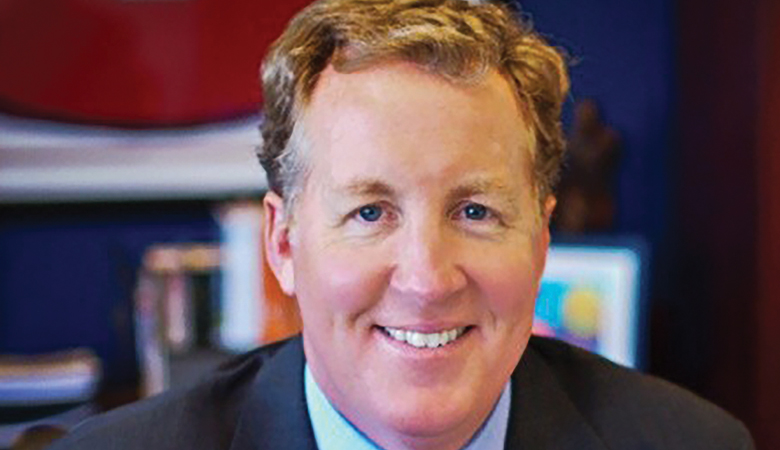
Jim Dotter
Joining Dotter for the interview was Mike Horvath, corporate director of industrial print sales for Edwards Business Systems. He was a welcomed addition to the company in 2011 with long-standing prior experience in production print at Xerox.
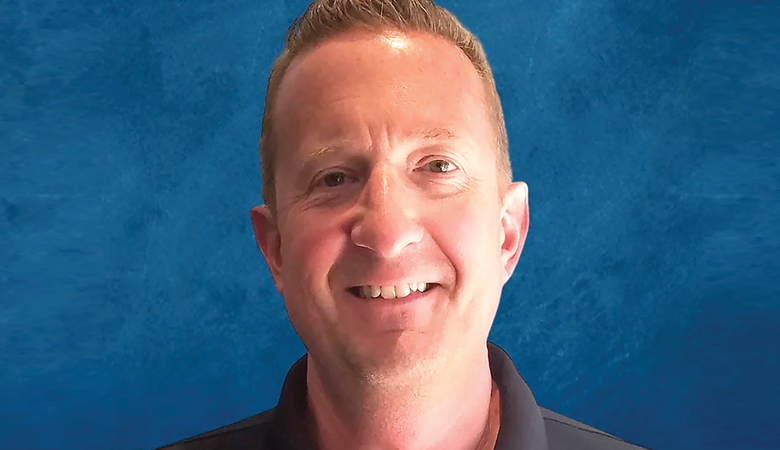
Mike Horvath
TCR: How long has Edwards Business Systems/Virginia Business Systems been involved in production print?
Dotter: I don’t recall the exact date, but it was in the 1990s. Our first product was the Konica Minolta 7090. Back in those days, it was referred to as the 90 series. They put the speed first and then the year.
TCR: Besides Konica Minolta, do you represent any other production print lines?
Dotter: We have Xerox and thanks to Mike, we have done well with that product line since he joined us. We did bring in two other individuals to complete the team.
TCR: Do you carry any kind of finishing lines/support products?
Horvath: Yes, MBM Corporation out of South Carolina. We sell a line of cutters to complement offline finishing capabilities, and we also work with Brett Graphics for binding and finishing equipment.
TCR: A lot of dealers are not knowledgeable about production print and don’t understand that finishing products contribute to the overall revenue. You obviously do.
Dotter: We see lots of opportunities and synergies and gains with a lot of our customers—a lot of success with this. It adds revenue and is a very important part of the sale.
TCR: Jim, when you started in the 1990s, how did you first sell the production products?
Dotter: Initially, our sales team was responsible for selling copiers into the office environment. A few of them had accounts with print shops asking for production products. Leaning a bit on our OEMs, they helped us a great deal. As I said, we brought in people from the outside as well as background support.
Any dealer starting out in production should bring in people with experience in that area. It helps the rest of the organization learn about the business. It also gives you time to train some of your better salespeople who you believe are fully capable of learning. It takes time.
TCR: If I’m a dealer that wants to get into production print, what type of person would you tell them to invest in?
Dotter: Sales. You need to have someone who knows how to respond to prospects. After that, you need to address the service issue, not just the break-fix, but the workflows and the hierarchy. Mike Horvath is a great example. He was a seasoned production print salesman who knew the Xerox line cold. We were able to add Xerox to our offering, and we have been very successful with it.
TCR: How about sales support, service, and production print specialists?
Horvath: Experience with Fiery frontends is very helpful. In production print, the DFE [digital frontend] is very important. Someone who has been servicing products that are 60-ppm [pages-per-minute] with color output using Fiery is a good start. We teach sales reps how to identify opportunities, and then they bring specialists through the sales process.
TCR: Do you treat production print as a separate division?
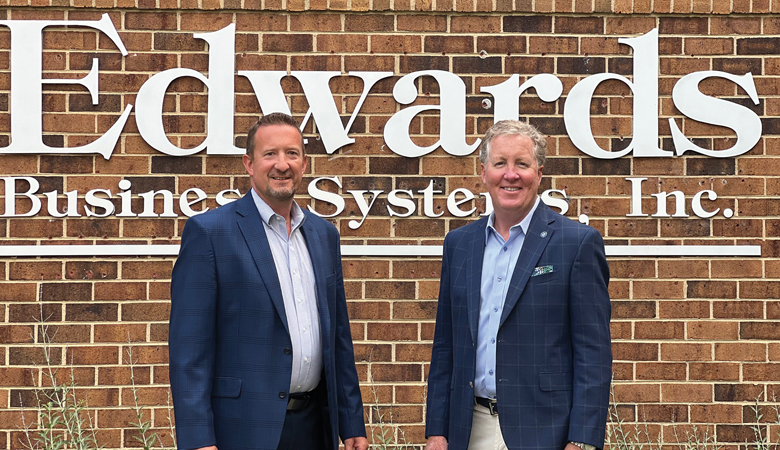
Mike Horvath and Jim Dotter.
Dotter: The production team works daily with the sales team. Compensation plans and commissions are split 50/50, giving each party 100% credit for a sale.
Horvath: Our unit is integrated within the organization but leads in production print. In my role as regional manager since 2016, having someone oversee our commercial print program was vital to our success.
TCR: Can anyone sell production print?
Horvath: Yes, the core focus of our production print team is to look primarily for production prospects. There is some crossover of accounts that have MFPs tied into the account, but primarily, they are hunting for production print opportunities across the board.
Dotter: We have three salespeople whose primary responsibility is production print. We have two in Pennsylvania and one in Virginia. We stress working together. The way we have constructed the comp plan works and is very profitable for everyone involved.
TCR: Where do your techs fit in?
Horvath: There is some crossover there, too. There are specialists in production print that we call on for other types of clients, but we invest in developing techs who are highly trained in all the equipment we sell. We have 27 factory-trained technicians throughout the company.
Dotter: We stress fix it right the first time, and they carry a lot of high-mortality parts.
TCR: How did your production print sales hold up during the pandemic?
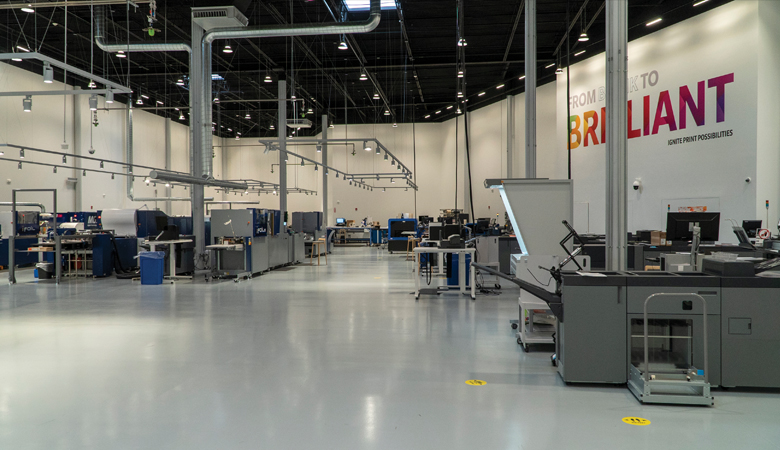
The print shop at Konica Minolta’s Client Engagement Center.
Horvath: Sales overall during that period turned out to be pretty good throughout 2020. It wasn’t until we hit the supply chain issues, which impacted that level of performance.
Dotter: It was decent. We survived. Konica Minolta and Xerox, our partners, were both hit by supply chain problems. At that point, it was doing anything we could do to keep our customers up and running until the equipment hit.
TCR: What was the percentage of your revenue from production print last year?
Dotter: Our production print business makes up 8% of our total revenue. We see this as a tremendous opportunity for us and have invested heavily in this business initiative. As for MBM Corporation cutters and finishing equipment, it is included in our production print numbers but it’s a relatively small percentage.
TCR: Looking at the overall business today, is there something you would like to see Konica Minolta offer in production print that could help you? There was one dealer in our Annual Dealer Survey who was big on small-format inkjet products, which is the reason for this question.
Horvath: Not at the moment. We are trying to increase visibility above and beyond the typical production print environment we sell to. This includes central reprographics, print shops, etc. We started elevating our game, getting into industrial print and wide format, and ramping up our service techs.
Right now, I feel Konica Minolta has done a phenomenal job of providing us with wide format products and services as we educate our team, and as we’re ramping up and preparing to get those products and services out into the marketplace. The same is true for Xerox. We feel we carry two of the best production and industrial print lines out there.
TCR: What are you doing to ramp up?
Horvath: I was referring to new products and services we haven’t sold before. Products such as the Konica Minolta AccurioWide wide format printer; we’re looking to get a better understanding of the opportunities that kind of product can give us. The same thing with commercial label presses. Also, we must get acquainted with a variety of software solutions that go with that. We’re improving our game, taking us from where we are to where we want to be.
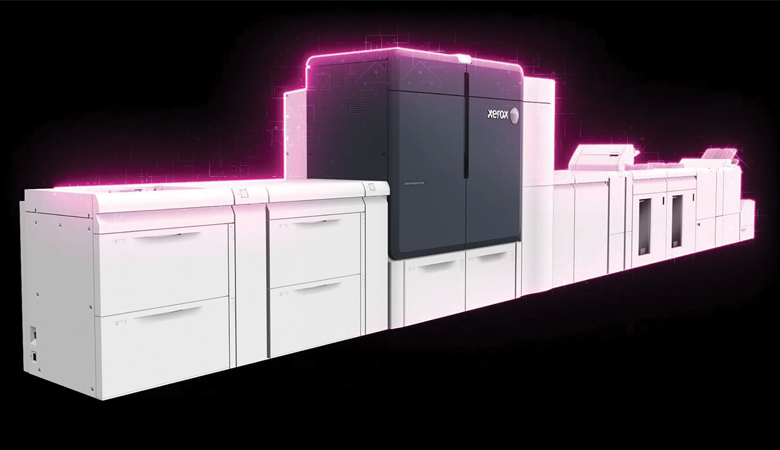
The Xerox Iridesse production press, one of the higher end production print devices sold by Virginia Business Systems and Edwards Business Systems.
Dotter: If you look at what Xerox has to offer, they didn’t think we could sell the Konica Minolta Acurio product, along with the Xerox Iridesse. Their experience was only selling through direct before they offered it to dealers, but we’re selling them now. On the Konica Minolta side, I’m sure you’ve been to the Konica Minolta Customer Experience Center. It’s an amazing facility.
TCR: Of your 12 locations, including the 11 that sell production print, do you have special areas to support production print?
Dotter: We have two—our High Valley and Richmond facilities support each region. Having a building like Konica Minolta’s Client Engagement Center available to dealers is a very good thing.
Horvath: We used to have an annual open house each fall dedicated to Xerox and Konica Minolta production print. We also explored areas for offline equipment from other sources, which often led to finding a new client and new opportunities. We’ll be starting up those customer events again since we’ve had great success with them.
TCR: Do you have any advice for a dealer getting into production print?
Horvath: As Jim said before, hire experienced people. People are your greatest asset. If they are application driven and understand the market, along with OEM support (SMEs), that will make a dealer successful.
Dotter: I agree, but it is a significant investment, and it’s not easy. You need a demo device, which typically costs six figures, so you must finance that in some way. Training, we’re big on that, so we go through extensive certifications. We have 11 of our locations that sell production print. We must be certified in all locations.
You’re not going to see the payoff right away. The sales cycle is much longer. Sometimes, you get bloodied a bit as you learn—faster response times, investments in parts and supplies, learning the workflow, hiring an analyst—there’s an expense to all of those. And make sure you’re doing this with the right manufacturer.
That can provide dealers with excellent industry insights and support. The other part is P4P [print for pay]. That looks like the easiest entry, but it is also the most painful. The reason why they are talking to you is because no one else will give them credit approval.
Dealer Appreciation
“Konica Minolta strives to offer industry leading capabilities that help our dealers grow through diversification and new revenue streams. We cannot overstate our appreciation for long-standing partners such as Jim Dotter and Virginia Business Systems, who support us in our continued investment in the production print space.” Dino Pagliarello, senior vice president of product management and planning, Konica Minolta Business Solutions U.S.A.
Visual Edge IT, North Canton, Ohio
Production Print Hardware OEMs: Xerox, Kyocera, C.P. Bourg
When we began our dealer profile series three years ago, the intent was to interview independent dealers and not any part of some rollup. That was short-sighted of us. What companies such as Visual Edge IT, UBEO, and FlexPrint are doing is equally special and noteworthy
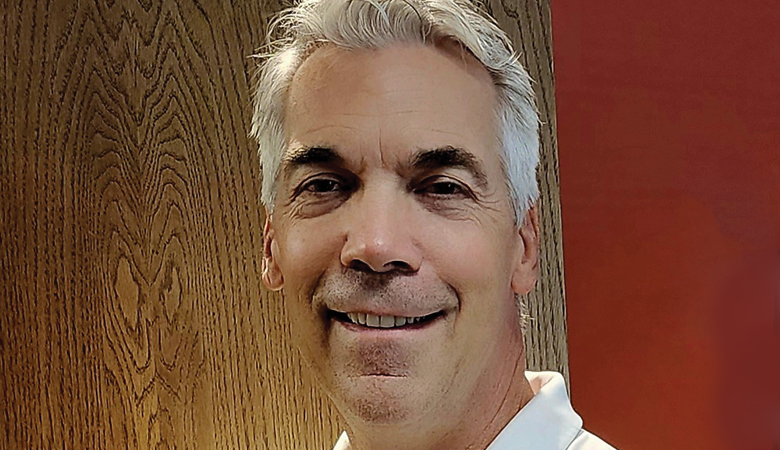
Brian Frank
According to Chief Executive Officer Austin Vanchieri, Visual Edge IT has acquired 35 dealerships and currently has 78 locations, providing the organization with unique coverage across the U.S. We were pleased to have Brian Frank, the firm’s chief operating officer, and Brad Craft, vice president sales and market development, participate in this interview.
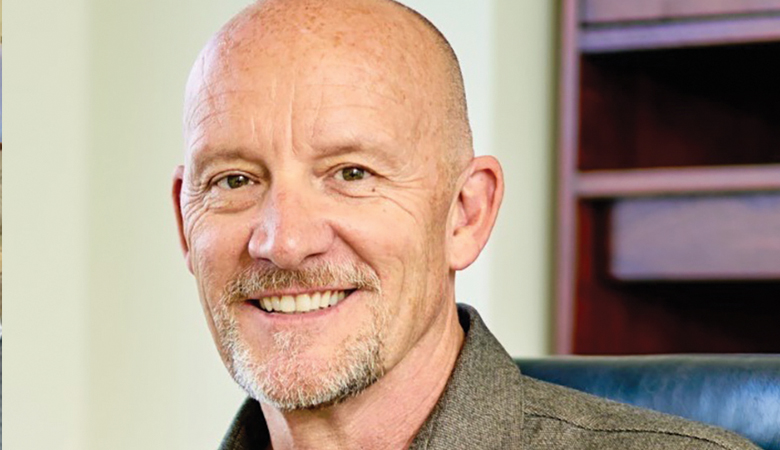
Brad Craft
TCR: How and when did Visual Edge get involved in production print?
Frank: At the point we started, we had already acquired 34 companies of which some had sold Konica Minolta production products. The reason we are doing so well in this area is because we acquired Brad’s company Image Source. They were our 28th acquisition. He and his team are the reason we are Xerox’s largest customer. Brad Craft’s company has 14 locations in California and does an incredible job.
TCR: I guess that is why Xerox said if you want to learn about how and why Visual Edge IT is so successful selling production print speak to Brad Craft. Brad, what did you do once you joined Visual Edge?
Craft: My background was all Xerox. I went from being an agent to acquiring other agents and finally becoming a dealer. We were fortunate that we made the investment in developing experts in the field of production. Once we were acquired by Visual Edge IT in 2016, we became a source of information for the other locations about the reasons we were so successful with Xerox production. At that point, those that were into production were selling Canon and Konica Minolta. We shared what we were doing with Xerox.
TCR: I gather that makes you the head man in production print for Visual Edge IT?
Craft: That is not my title, but I believe we serve as a leadership model on production for the rest of Visual Edge.
Frank: Brad had a whole team of production specialists. Because, in large part, we decided last year that copiers were flat and even declining while production print is a growth market, and he has led our efforts.
TCR: What brands besides Xerox are you selling today?
Craft: We have added Kyocera to our Xerox offering. We believe it is a very good product that fills a particular need in the market. We have sold six TASKalfa 15000cs in California to date.
Frank: Thanks to their knowledge of production, Brad’s team sold the Xerox Iridesse, a $1-million printer. It was Brad’s suggestion to take on Kyocera and that is proving to be a very good market.
TCR: Overall what percentage of your revenue does production print represent?
Frank: Production has been very successful since Brad became vice president of market development. I think it is only six months. As a guess, it is currently about 6%.
TCR: Do you carry other product lines such as finishing that are sold in conjunction with the printers?
Craft: Visual Edge IT offers a full line of finishing, mail, and software/workflow automation solutions from many different manufacturers. These finishing, mail, and software/workflow solutions can be in-line with the different printers or full offline solutions. This allows Visual Edge IT to formulate the best technology and the right workflow for a client that would allow them to be as productive and efficient as possible.
Visual Edge IT’s strategy is to be a total solutions provider in the production print space leveraging our expertise. We work with quite a few brands, and C.P. Bourg is one that we can mention.
TCR: We understand when you sell a production print device, it is a big ticket. Is there anything else you can gain along with it?
Craft: The revenue increases when you have the types of companies that are spending the money necessary to acquire these large printers and are also potential clients for IT, as well as MFPs. At the same time, when you are financing larger products, you must have a finance partner that not only provides a lease but also gives you the kind of support that conventional leasing partners do not provide.
Xerox has stepped up and recognized these production print clients have different kinds of requirements. For example, clients can ask for a 72-month lease, and the conventional leasing partners will only go to 60 months and prefer to offer fewer months than that. Xerox leasing helps in several ways, including helping us find prospects.
TCR: Brian made it clear that since you joined Visual Edge IT, their production print business has taken off. What recommendation would you give to a dealer who is looking to get into the production space? Specifically, what kind of person should they consider bringing in or type of person they can promote from within?
Craft: You must have someone who knows how to talk to a person running a shop. It is a different language, and all the pieces going through the device are different. They must be familiar with terms such as registration, back-and-back, and many others. What we have found is that a selling skill is first and foremost, rather than service specialists. Once the sales rep gets the revenue involved with production, they want to go and get it done.
Frank: It is about profitably increasing your revenue and offering a career path for those who are at the top of the curve in selling printers. For a salesperson who wants to get a bigger income, the answer is to sell production print. Simply stated, it offers a career path that most dealerships do not have.
TCR: Do your vendors provide you with sales support—subject matter expects (SMEs)—to help with challenging prospects?
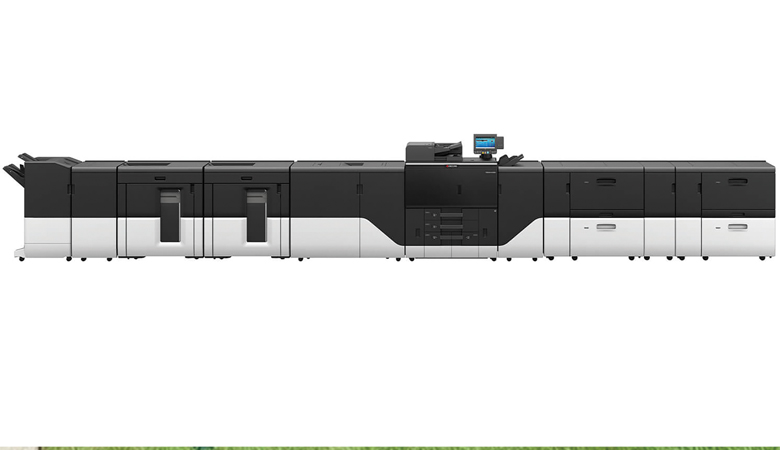
Visual Edge has been successfully selling Kyocera’s TASKalfa Pro 15000c, a high-speed inkjet production printer.
Craft: We have very good to great manufacturers, and what they are offering is a broad range of printers that satisfy almost all the applications involved in cut-sheet print. They put a lot of resources at our disposal that help us sell more. At this point, Kyocera has only one product, so they are doing very well supporting us. Xerox has SMEs that are referred to as “Tigers,” and they are there to support the sales in the field. They have extensive knowledge of production and know how to communicate it to the dealer.
TCR: How are your service techs trained on production printers?
Craft: Manufacturers help a great deal. They do not sell it if you cannot properly service it. When we started selling Kyocera before we were service trained, we partnered with them to get it going. That creates a partnership. All the manufacturers we deal with are very supportive in regard to service training.
TCR: Is there anything you would like to see your manufacturers provide that they are not doing?
Craft: I think there are small gaps in each manufacturer’s line. We are fortunate at Visual Edge IT, as we can pick and choose from four manufacturers. It gives us the ability to mix and match so that we can easily satisfy the customer’s need and fill that gap.
TCR: Of all the locations you have, are there any that really stand out in their performance, and where are they located and in what market segments are they successful?
Craft: California with 13 offices. They do more production than anyone else in the country. Commercial printing is very helpful, and we do a lot with the government whenever possible. If you want to be successful in the enterprise, you must provide printers for their CRD. If you do not have that you are not going to be able to get into many of those accounts. This is where we can help Visual Edge IT selling MFPs fleets to the enterprise.
Praise from Xerox and Kyocera
“Visual Edge IT is dedicated to delivering the best production print technologies and client experience. As a result, they are seeing tremendous growth nationwide with Xerox’s production print portfolio. We continue to invest in our end-to-end production print ecosystem using our more than 50 years of expertise in production print to help our dealers meet the varying needs of their clients as they expand their businesses.” Mike Pietrunti, senior vice president, U.S. Channels Leader, Xerox
“We continue to be impressed and excited by the success Visual Edge IT is having with the TASKalfa Pro 15000c as a key part of their production portfolio. It’s not just the successful placements, but the investments working with our team to learn about the product, and the best fit for the technology. The vision that Visual Edge IT has for its future in production print aligns well with the investments Kyocera is making to grow into a force in production inkjet.” Óscar Sánchez, president and chief executive officer, Kyocera Document Solutions America
5 Common Production Print Success Denominators
In this issue, we interviewed three successful dealers who are highly proficient in selling production print. The three are engaged with Canon, Konica Minolta, Kyocera, Ricoh, and Xerox.
This brings the list to 10 dealers we have interviewed over the last three years about production print. As we stepped back and reviewed what they had to say there were several common denominators.
- To take on production print you need to have someone who is fully conversant in this area because they can speak the language. In addition, they can help you make the correct decisions that must be made. Perhaps this person you employ was employed by the manufacturer.
- Select a manufacturer that will give you all the necessary support on the sales and technical services side. You must be able to rely on their expertise to assist your sales team in properly addressing customer expectations and demand. This simply means that the manufacturer has SMEs. Your salespeople must have access to these experts as they encounter applications they are not familiar with. The manufacturers addressed in this issue are all supportive to certain degrees. That should be explored, and questions should be asked of the rep calling on the dealer that will sell them the printers.
- If you employ a lead person who has worked for a manufacturer, ask what their deliverables are in the areas mentioned.
- Attend print exhibitions and conferences. Be sure to take advantage of the educational seminars. Walk the floor and ask questions about the products and their distribution policies. Not all are enthusiastically engaged in selling through dealers. Learn not only about the manufacturers you intend to represent but also what the competition is like. The major conference is PRINTING United. We would suggest you take it in. Do the same thing after you have taken on a line and stay current with new introductions.
- Prior to receiving your first demo product (that can cost six figures) determine where and how you will set it up. You may have difficulty coming up with a location for the demo model. If you are in proximity to the manufacturer, ask if they have a production print demo area where you can bring a customer to their location. An example would be Konica Minolta’s Customer Experience Center in Ramsey, New Jersey. Canon U.S.A. has an excellent facility in Boca Raton, Florida, that you may be able to bring clients to. Ricoh USA also has one in Colorado.
Dealer Production Print Demo Strategies
In this issue, we interviewed EO Johnson. Ten years ago we visited their production print building in Wisconsin. It is state of the art. In their interview, they indicated that their closing rate is very high when prospects are taken to that location.
Some years ago, we also visited with Keith Allison of Systel Business Equipment in Fayetteville, North Carolina. At the time, his dealership had five locations. He was aware he needed a special area that all the branches could use to demo the production printers. He bought a commercial printer that was situated equidistant from each of his branches.
That shop featured all the models he wanted to sell. Salespeople were informed when they wanted to visit the production site to make an appointment and have the client bring a file that they would like to see printed. They have the opportunity in such an environment to possibly upgrade the sales. At that time, Allison said the closing rate was in the 90% range.
To the best of our knowledge, Systel is the only Konica Minolta dealer who purchased a KM 1. Visual Edge IT has also sold a Xerox Iridesse printer. Both of those sell for $1 million.
This is where dealers shine. Learn from dealer friends, particularly at the manufacturer meetings and incentive trips. Simply ask them how they are doing in production. That would be the best source of all.
In summary, print is neither dead nor even dying. It is moving into printing onto other substrates. The hottest market in print is packaging, labeling, and textile printing. Those are markets a dealer can compete in once he becomes well-versed in cut-sheet printers.
Large and wide format printing is a companion piece to production print and a very profitable one. Fueled by inkjet the supply revenue is outstanding. These devices employ inkjet technology and with the large format printers, the ink comes in 55-gallon drums. The margins on the ink are substantial.
This is all part and parcel of industrial printing. Take that first step and down the road be prepared to enter a burgeoning market that is measured in billions of dollars. Textile printing alone is a $13 billion market. This is how you build revenue, profitability, and sustainability.
We welcome any questions readers may have regarding production print and we will be happy to respond as best as we can. Email me your questions at fgcannata@cannatareport.com. Do not hesitate to ask us to address whatever is on your mind.

